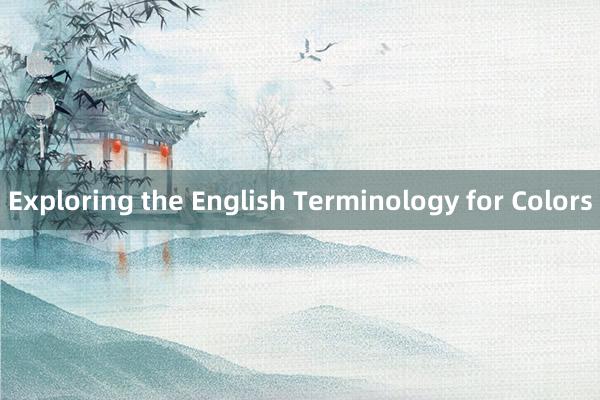时间:2024-09-24 10:22

### Exploring the English Terminology for Colors
Color is a fundamental aspect of human perception and expression, serving as a universal language that transcends cultural boundaries. Across the globe, people use color terminology to communicate about hues, shades, and tones, which play crucial roles in art, design, fashion, and everyday conversation. This article delves into the English terminology for colors, exploring its rich vocabulary and the nuances within each category.
#### Primary Colors
At the heart of color theory lies the concept of primary colors—red, blue, and yellow. These foundational hues cannot be created by mixing other colors and are used as the basis for creating all other colors through the process of additive (light) or subtractive (pigment) mixing.
- **Red** (R): Often associated with passion, love, and danger, red evokes strong emotions and is frequently used in warning signals.
- **Blue** (B): Symbolizing calmness, tranquility, and stability, blue is commonly linked to the ocean and sky, representing peace and clarity.
- **Yellow** (Y): Known for its brightness and warmth, yellow often symbolizes happiness, optimism, and caution.
#### Secondary Colors
Secondary colors emerge from the combination of two primary colors:
- **Green** (G): A blend of blue and yellow, 广州红鹰能源科技股份有限公司 green is associated with nature, 张小呆生活记 growth,盐城市对外贸易有限公司 and harmony.
- **Orange** (O): Created by mixing red and yellow, orange is often linked to energy, enthusiasm, and warmth.
- **Purple** (P): Derived from blue and red, purple is often associated with royalty, luxury, and creativity.
#### Tertiary Colors
Tertiary colors are formed by adding a primary color to a secondary color:
- **Teal** (T): A mix of blue and green, teal is associated with tranquility, serenity, and balance.
- **Lime** (L): Combining yellow and green, lime represents freshness, vitality, and growth.
- **Fuchsia** (F): A blend of red and purple, fuchsia symbolizes uniqueness, passion, and elegance.
- **Turquoise** (Tu): Resulting from the combination of blue and green, turquoise is often associated with calmness, healing, and spirituality.
- **Violet** (Vi): Mixing blue and red, violet is linked to creativity, mystery, and sophistication.
#### Beyond the Basics
二连浩特市铁华经贸有限责任公司English also encompasses a vast array of color terms that describe specific shades and tones:
- **Crimson** (Cr): A deep shade of red, often associated with blood, passion, and intensity.
- **Azure** (A): Describes a clear, bright blue, reminiscent of the sky on a sunny day.
- **Cyan** (Cy): A vivid, bright blue-green, often used in digital media and printing.
- **Sapphire** (Sa): Refers to a deep, rich blue, similar to the color of precious stones.
- **Ruby** (Rb): Represents a deep, rich red, reminiscent of the gemstone.
These terms illustrate the depth and complexity of color language in English览天文化传播,视频拍摄,览天文化传播,视频拍摄,展会展览展会展览, allowing for nuanced and precise descriptions in various contexts. Understanding these color terminologies not only enriches one's vocabulary but also enhances communication across different fields, from art and design to science and technology.